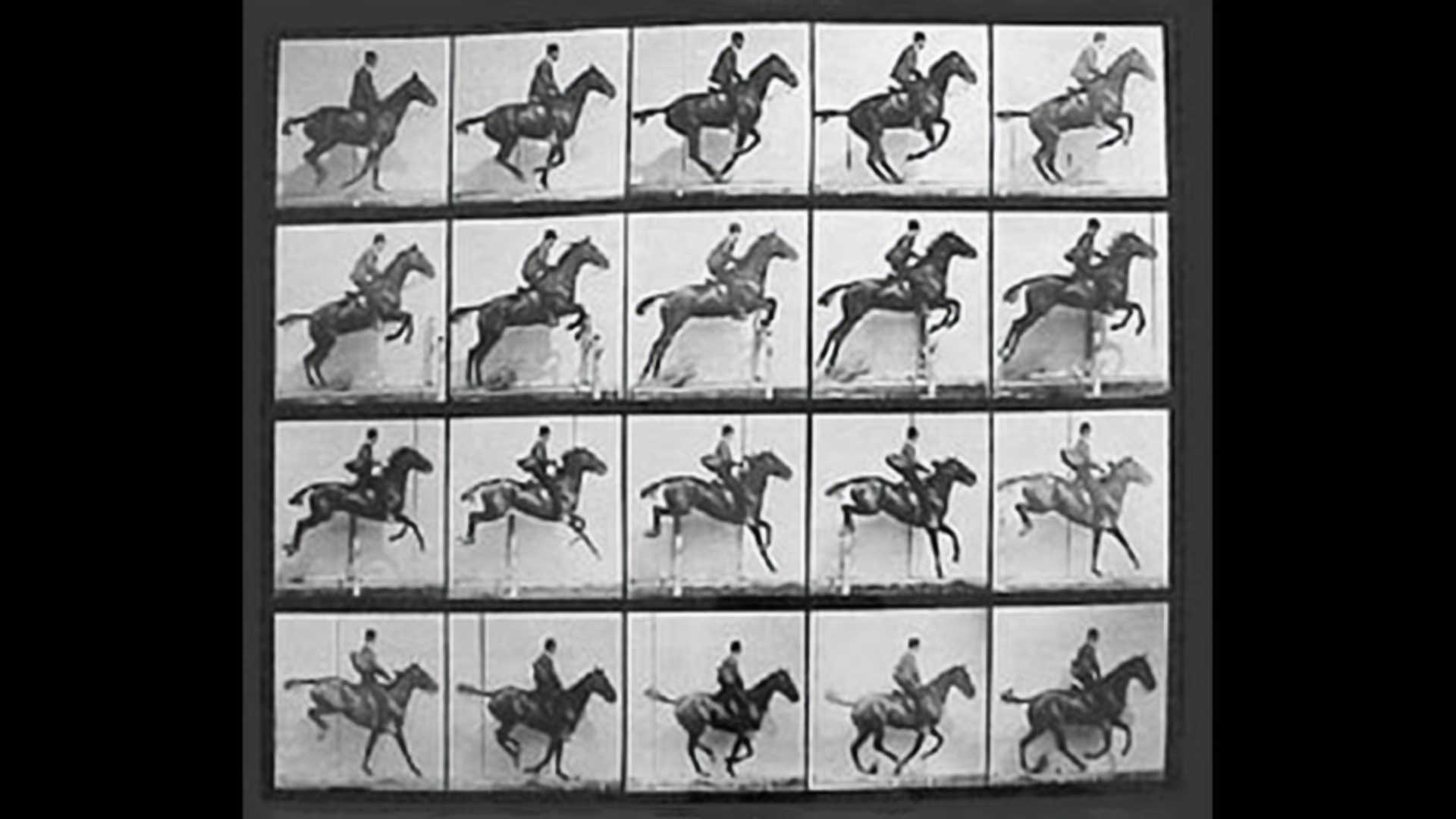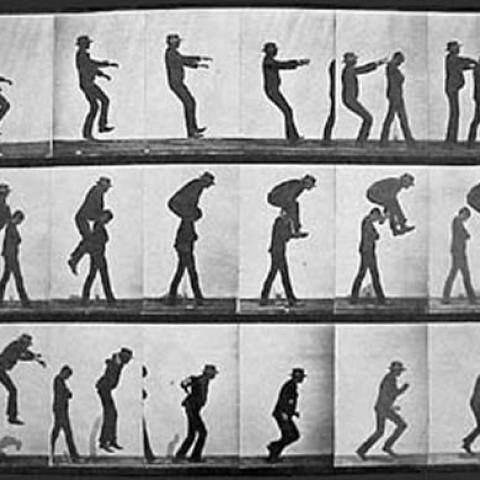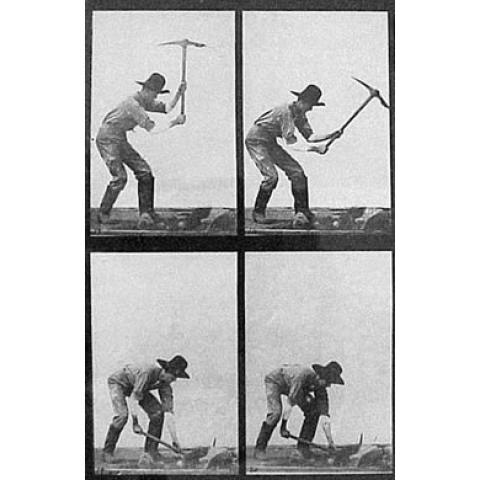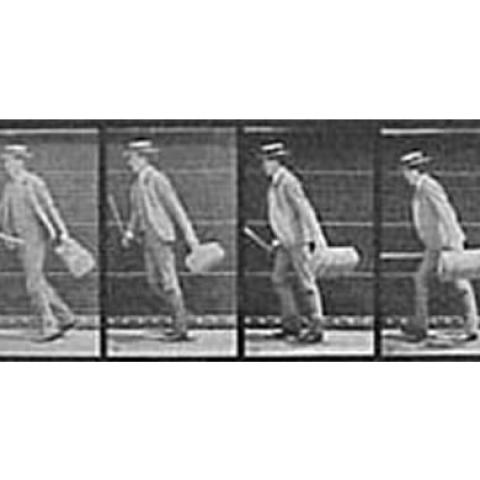
Eadweard Muybridge was born Edward James Muggeridge in Kingston-upon-Thames in 1830. He traveled to the United States in 1852 with the notion of someday changing his name to use the Saxon spelling (he eventually did by 1867). Muybridge worked as a commission merchant for American and English book publishers on the East Coast for a few years before moving to San Francisco. There he worked as a book dealer until 1860, offering finely illustrated American and English works. In that time, Muybridge was elected to the board of directors of San Francisco's Mercantile Library Association, a position of considerable honor.
Although he had worked with photographers in New York and San Francisco, Muybridge himself did not seriously take up the art until sometime between 1861 and 1866, when he was back in England recovering from a near-fatal stagecoach accident. The accident changed him dramatically, in person as well as profession. Treated by a physician known for his belief in "natural therapy"—rest and outdoor activity—Muybridge devoted himself to photography, concentrating on outdoor views as part of his natural therapy. He returned to San Francisco in 1867 as an "artist- photographer," and quickly became one of the foremost landscape and general view photographers on the West Coast.
Muybridge used the wet-collodion photographic process introduced by the Englishman Frederick Scott Archer in 1851. Besides being more light-sensitive than other processes (allowing shorter exposure time), this process made fine detail possible. The prints looked almost like daguerreotypes on paper. His Scenery of the Yosemite Valley of 1867, offered as the work of "Helios," was held in high regard and brought him much acclaim. Muybridge was commissioned to work on several photography projects, including an expedition of the Alaskan Territories and documentation of Pacific Coast lighthouses.
Muybridge repeatedly announced in his advertisements that, "Helios is prepared to accept commissions to photograph Private Residences, Views, Animals, Ships, etc., anywhere in the city, or any portion of the Pacific Coast." In 1872, former Sacramento governor and railroad builder Leland Stanford wanted a photograph of his racing horse Occident trotting at full speed. This collaboration led to Muybridge's first photographic analysis of motion.
"I'm going to make a name for myself. If I fail, you will never hear of me again." ~ Eadweard Muybridge, ca. 1852
Stanford had a theory that at some point in its stride, a trotting horse has all four feet off the ground at the same time. He had tried various ways of measuring the horse's footfalls, but none were successful. Muybridge was amazed by the proposition. In an excerpt from an anonymously published essay, he wrote:
...Mr. Muybridge therefore plainly told Mr. Stanford that such a thing had never been heard of; that photography had not yet arrived at any such wonderful perfection as would enable it to depict a trotting horse at speed. The firm, quiet man who had, over mountains and deserts and through the malignant jeers of the world, built the railroad declared impossible, simply said: "I think if you will give your attention to the subject, you will be able to do it, and I want you to try." So the photographer had nothing to do but "try."
Muybridge took the picture and Stanford was satisfied with it, but unfortunately, this and a few other early attempts were not published. In 1874, the two expanded their photographic experiments. Muybridge learned of an instrument called the Phenakistoscope or Zootrope, that presented a "series of successive images of persons or animals represented in various attitudes. When these attitudes are coordinated so as to bring before the eye all phases of movement, the illusion is complete; we seem to see living persons moving in different ways."
In early June of 1878, Muybridge made his first successful serial photographs of fast motion at Stanford's California stock farm. The photographs were of a horse running and another horse trotting; they were developed on the spot so as not to be accused of doctoring the images. Muybridge began traveling, giving lectures and demonstrations of his work around the world. In August of 1883, the University of Pennsylvania in Philadelphia decided to sponsor Muybridge's further experiments. This setting was quite suitable to him. Philadelphians Fairman Rogers (scientist and then head of the Pennsylvania Academy of Fine Arts) and Thomas Eakins (painter, sportsman, and student of anatomy) were both members of a university commission formed in 1884 to supervise Muybridge's work.
Up until 1886, Muybridge took thousands of photographs and redid more than 500 of them. He worked at the Zoological Garden, and also photographed many human models. Animal Locomotion was finally published in November of 1887, and contained 781 plates. Muybridge had created an encyclopedic anatomy of motion, depicting humans and animals in various stages of work, play, and rest. The photographs shown here are just a sample of the many Muybridges that The Franklin Institute has in its collections. Fortunately, "the photographer had nothing to do but try." Muybridge's work, equally valuable to artists, scientists, and photographers, is considered the birth of early motion pictures.
All images pictured here are from The Franklin Institute's Animal Locomotion collection. © 1887, Eadweard Muybridge.
Reference: Eadweard Muybridge. Muybridge's Complete Human and Animal Locomotion. All 781 Plates from the 1887 "Animal Locomotion." Volume I. Dover Publications, Inc. 1979.
Note: The objects pictured above are part of The Franklin Institute's protected collection of objects. The images are ©The Franklin Institute. All rights are reserved.




